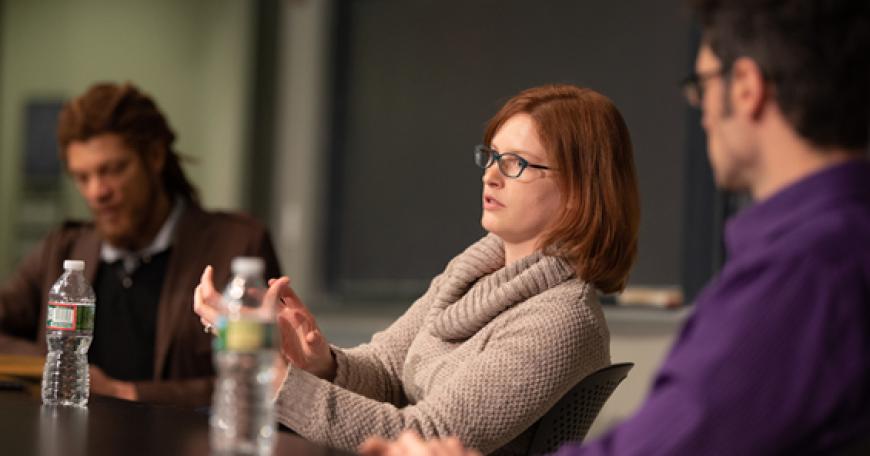
Virtual Experience, Real Liberation; Technologies for Education and the Arts
In the panel session at the Festival of Learning, three innovative leaders showcased diverse applications of virtual reality. From immersive therapy for rehabilitating verbal abusers to the possibility of artistic creation, these presenters showed the potential of virtual reality to extend far beyond the stereotypical. The prevailing theme throughout emphasized the power of virtual reality to create real and impactful experiences to be applied back in the ‘real world.’
First, professor of CMS/SAIL and director of the MIT Center for Advanced Virtuality, D. Fox Harrel described the use of extended reality (XR) technologies for social empowerment and learning. His view of virtual reality allowed people to “explore aspects of themselves, environments, and societies, imaginatively constructed atop the physical world.” Addressing the relatively untapped potential of XR, he emphasized the need for a thoughtful approach to these technologies. Thus, his development framework consisted of: studio (making), lab (researching impacts), salon (sharing), and hub (enabling, involving students and shared resources). One of his projects included researching the impact of virtual bodies and platforms to learn CS through games. His research probed the fascinating question of what virtual identities are best for learning. Are abstract avatars better? Does the body shape or race affect the player’s performance? Harrel closed with a poignant project, which uses VR in photojournalism to depict war and conflict. Participants from conflict regions were immersed in a virtual environment in which they were confronted with avatars representing ‘the other’. While society and history continually create the image of ‘enemy’, this VR experience worked to ‘humanize the other to break [these] cycles of conflict.’
Continuing the themes of representing ‘the other’, professor of math and CS at Davidson College, Tabitha Peck used immersive virtual environments to combat implicit bias and stereotype threat. She employed the phenomenon of embodiment illusion, a phenomenon in which participants experience the illusion that their avatar (or virtual body) has replaced their own self at both a physical and functional level. Reminiscent to me of the work of Ramachandran and other neuroscientists/psychologists, Peck demonstrated the deep link between perceived self and behavior. For example, Peck addressed the phenomenon of stereotype threat in which members of minority groups underperform when aware of the stereotype. For example, women in STEM underperform on exams when told that the scores depend on gender, compared to when told that gender had no effect. However, when the women saw themselves represented by a male avatar in an immersive virtual environment, the underperformance trend was alleviated. A similar concept of embodiment allowed rehabilitating verbal abusers to experience the position and emotions of a victim within the virtual environment; the majority reported a breakthrough in their therapy.
Moving from social roles to art, professor of the practice of music technology at MIT, Eran Egozy also used embodiment illusion to enable non-musicians to experience the reward of advanced music-making and composition. As co-creator of the famous GuitarHero and other games, and a musician himself, Egozy had long thought about the high barrier to the most rewarding musical experiences. Specifically, the years of practice and slow progress can often deter people from mastering instruments. The first of their kind, GuitarHero and its cousins, allowed people to ‘embody’ a rock star, complete with guitar and soundtracks. The goal was to give users a foretaste of the highly-rewarding musical experience, usually only attainable after years. Egozy emphasized the role of agency; how users feel in control of the music-making process. He hoped that the foretaste of agency and joy in music-making would inspire people to invest the time to actually learn the instrument.
Although seemingly fragmented, all these stories converge upon the power of self-perception. In our society, we constantly see ourselves as others perceive us – a phenomenon that critically affects our behavior. The speakers in this panel present novel resources and theories to help us construct better images of ourselves. These experiences, literally in the skin of another profession, race, or gender group, or on other side of a violent political conflict, impactfully redefine our view of who we are and what we can accomplish. Importantly, Egozy, Peck, and Harrel present exciting, unpredicted roles of VR in current and future society.
Video of Profs Harrell, Peck, and Egozy's panel.
 Zoya Fan, MIT '19, is majoring in Biology and Global Studies
Zoya Fan, MIT '19, is majoring in Biology and Global Studies

